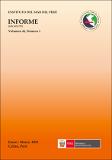Por favor, use este identificador para citar o enlazar este ítem:
https://hdl.handle.net/20.500.12958/3331| Título : | Línea base del sitio piloto Punta San Juan: Recursos pesqueros |
| Otros títulos : | Baseline survey of the Punta San Juan Pilot site: Fisheries resources |
| Autor : | Flores Castillo, Daniel Tejada Cáceres, Alex Sarmiento Bendezú, Héctor Muñoz, Roger Macalupú Rosado, Joe |
| Palabras clave : | recursos bentónicos;Línea base;punta San Juan |
| Fecha de publicación : | 2019 |
| Editorial : | Instituto del Mar del Perú |
| Citación : | Inf Inst Mar Perú 46(1), 2019, p. 78-87 |
| Citación : | Informe IMARPE;46(1), 2019 |
| Resumen : | La zona de estudio comprendió en su extremo sur el
área asociada al Programa Piloto Demostrativo (PPD) de la Comunidad Pesquera Artesanal de Marcona
(COPMAR) y se extendió por el norte hasta la Reserva Nacional San Fernando (RNSF). Con el objetivo
de determinar la distribución y abundancia relativa de los principales recursos costeros en el Sitio Piloto
Punta San Juan del Proyecto GEF PNUD Humboldt se realizó un Estudio de Línea Base (ELBA) entre 21
de enero y 3 de febrero 2014; el monitoreo se efectuó del 19 de febrero al 2 de marzo 2015 en estaciones
seleccionadas en ambientes submareales e intermareales, con muestreos cuantitativos y cualitativos. Se
ejecutaron transectos perpendiculares a la línea de costa en la zona de estudio, abarcando los ambientes
intermareal y submareal (5, 10, 15 y 20 m de profundidad) considerando el criterio tipo de sustrato: blando,
duro y mixto. Durante el ELBA se analizaron 34 recursos de importancia comercial, correspondiendo
14 a peces, 12 a moluscos, 3 a equinodermos, 3 a crustáceos y 2 a macroalgas. En el monitoreo 2015 se
identificaron 24 recursos, correspondiendo 11 a moluscos, 3 a equinodermos, 2 a crustáceos, 6 a peces y 2 a
macroalgas. Las zonas con mayor presencia de recursos fueron Punta San Juan, Basural, Choza Caída y El
Faro de San Nicolás. Los recursos con mayor frecuencia de ocurrencia fueron Lessonia trabeculata “aracanto
palo”, Romaleon setosus “cangrejo peludo”, Cancer porteri “cangrejo jaiva”, Thaisella chocolata “caracol”,
Cheilodaytilus variegatus “pintadilla”, Fissurella latimarginata “lapa negra” y Loxechinus albus “erizo rojo”.
En el análisis de la pesquería destaca la diversidad de recursos pesqueros, siendo L. trabeculata el recurso
más abundante. ABSTRACT: The study area included in its southern end the area associated with the Demonstration Pilot Program of the Artisanal Fishing Community of Marcona (COPMAR in Spanish) and extended north to the San Fernando National Reserve (RNSF in Spanish). Between January 21 and February 3, 2014, a Baseline Survey was conducted to determine the distribution and relative abundance of the main coastal resources at this Pilot Site as part of the UNDP/ GEF Humboldt Project. From February 19 to March 2, 2015, the monitoring was carried out in subtidal and intertidal environments, carrying out quantitative and qualitative sampling. We made transects, covering the intertidal and subtidal environments (5 to 20 m of depth) and considering the type of substrate: soft, hard and mixed. During the Baseline Survey, 34 commercially resources were analyzed (14 fish, 12 mollusks, 3 echinoderms, 3 crustaceans, 2 macroalgae). In the 2015 monitoring, 24 resources were identified, (11 mollusks, 3 echinoderms, 2 crustaceans, 6 fish, 2 macroalgae). The areas with the greatest presence of resources were Punta San Juan, Basural, Choza Caída, and El Faro de San Nicolás. The resources with more frequency were Lessonia trabeculata, Romaleon setosus, Cancer porteri, Thaisella chocolata, Cheilodaytilus variegatus, Fissurella latimarginata and Loxechinus albus. The analysis of the fisheries highlights the diversity of fishery resources, with L. trabeculata being the most abundant one. |
| URI : | https://hdl.handle.net/20.500.12958/3331 |
| ISBN : | 0378-7702 |
| Aparece en las colecciones: | Informe vol. 46(1) 2019 |
Ficheros en este ítem:
| Fichero | Descripción | Tamaño | Formato | |
|---|---|---|---|---|
| Informe 46-1 Línea base del sitio piloto Punta San Juan.pdf | 1,47 MB | Adobe PDF |  Visualizar/Abrir |
Este ítem está sujeto a una licencia Creative Commons Licencia Creative Commons

